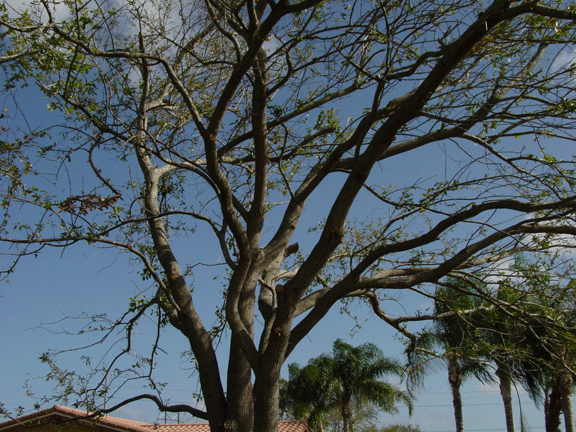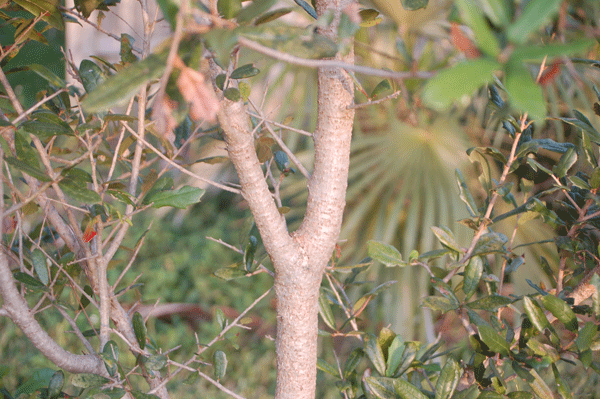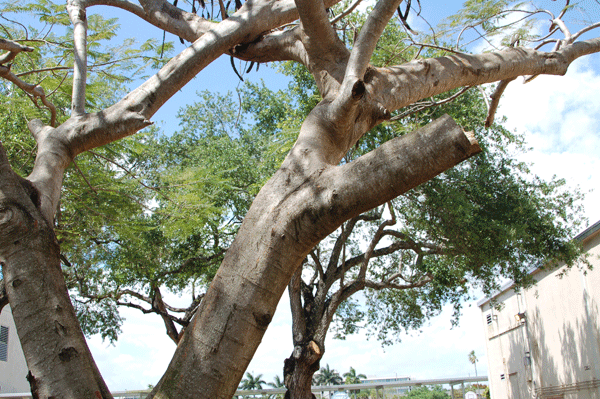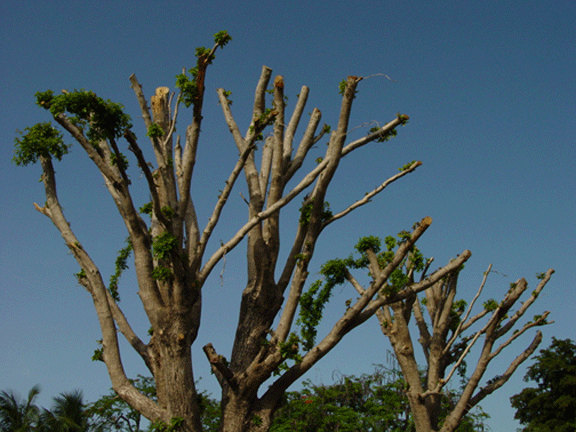Pruning in South Florida

As published in the Miami Herald
Pruning is done to control size or shape, to promote flower and fruit production, to remove unhealthy portions of a plant and to open trees up to make them less likely to fall or break apart during a storm. True pruning is an art which takes time and thought. Before you make your first cut, study the plant’s natural shape and try to picture this plant in three to four years. Try to maintain that shape in your mind as you prune. This will help you to make the sometimes difficult decisions associated with pruning. Pruning large trees to bring them down to size is not an acceptable reason to prune (except in the case of some fruit trees) and can be remedied by putting the right tree in the right location: choose a tree that will grow to the height you want, don’t try to maintain the height by heavy pruning.
 |
| A properly pruned tree allows light and wind to pass through it. |
Pruning Trees
Before you start pruning, you will need to select the proper tools for the job. Three tools will be invaluable: a hand pruner, a lopper and a hand saw. Each tool should be of high quality and compatible with the user. Making sure your tools are properly sharpened and in good condition will greatly ease your job of pruning. Chainsaws are not a necessary part of pruning. A person with a chainsaw tends to make quick decisions that are quickly carried out with the aid of the chainsaw. Using a hand saw for your major cuts will allow you to think through your decisions before they are implemented.
There are two main types of cuts: thinning cuts and heading cuts. A thinning cut is made on a branch all the way back to a major limb or trunk of the tree. This type of cut is good to control height as well as open up the tree. The other major type of cut is known as a heading cut. The heading cut is made toward the end of a branch near a node or growing point. Heading cuts are used when you want to make a branch break buds and create multiple growing points.
 |
| Before a thinning cut. |
When a thinning cut is made, it is important to make the cut in the proper position on the tree. Do not leave an obvious stub when a cut is made. The stub will either die and create a weak point in the tree or it will re-sprout. Both conditions are undesirable. Do not make a flush cut all the way back to the trunk or major branch. While a flush cut is visually appealing, it removes what is known as the branch collar. The branch collar appears as a swelling at the base of most branches and must be left because it will aid in the healing of the wound created by the pruning cut. If the collar is removed, the wound may never heal leaving the tree open to fungal attack and rot.
 |
| After a thinning cut. |
When you are ready to begin pruning, look for unhealthy conditions such as included bark, dead wood or crossed branches and remove those conditions as you prune. Remember that each cut you make on the tree is unnatural and is causing the tree stress by producing a wound on the tree. With that in mind, keep pruning cuts to a minimum and never remove more than one third of the tree’s overall canopy.
Included bark occurs when two branches or trunks grow so close that they join and create a V as their width increases making the trunks vulnerable to splitting. This situation may be remedied by removing one of the included branches. Usually the largest branch is left in place and the smaller branch removed.
Dead wood offers a prime entry point for wood borers, as well as bacteria and fungi that can damage your tree. Carefully cut away any dead wood from the tree while avoiding cutting into the healthy portion of the tree. When dead wood is left in a tree, it is a hazard as it may fall at any time.
Crossed branches are unhealthy. When branches cross, there is a likelihood of the branches rubbing together and creating a weak point in the tree as well as an entry point for pathogens. The smaller of the crossed branches should be removed.
Now that the obvious cuts have been made on the tree to improve its health, it is time to step back and look at the tree. This is the time in pruning when your mind is just as important as your saw. Decide what cuts need to be done in order to open the tree to decrease wind resistance, but at the same time maintain the overall shape of the tree.
 |
| This heading cut is too large and leaves a large wound. |
Some branches are so heavy that if you tried to remove them, they would begin to fall before a full cut was made which would result in a tearing of the branch. In order to avoid tearing a branch when a cut is made, a three step cut should be employed on all branches over two inches in diameter.
1) Begin with an undercut 3 to 4 inches from where your final cut will be made. The under cut prevents the limb from tearing.
2) Make the second cut from above matching it with your undercut. This cut will remove the weight of the limb.
3) The final cut removes any remaining portion of the limb. This cut should leave only the branch collar of the tree.
Beware of pruning companies that offer to hurricane-proof your trees by employing a simple but devastating technique known as hatracking. Hatracking is a process where the pruner simply draws an arbitrary line at some point in the canopy and removes everything above that line: sometimes 50 to 100% of the tree’s canopy. Hatracking has many detriments: it will open up the previously shaded interior of the tree to sunscald; it creates massive re-growth at each cut (three to four branches will sprout at each cut); and the tree will re-grow what has been lost within a year and will therefore be in need of pruning once again. The matter of massive re-growth is of top concern because it creates a weak canopy that will break up in a hurricane. Hatracking usually involves making major heading cuts on branches over three inches in diameter. When these branches heal themselves, they create a barrier zone of dead wood at their tip in the shape of a V. When three to four branches grow out of this branch, there is not a lot of healthy wood for the new branches to be attached to and they are therefore weakly attached and dangerous branches that can fall in even minor wind. Hatracking is done because it is easy and it lets the client know that work has been done on a tree. Avoid it at all costs. A tree that has been pruned correctly will not look as though it has been heavily pruned.
 |
| Hatracking is never a good idea. |
Pruning Shrubs and Small Trees
When pruning shrubs, one can take a more heavy-handed approach to the art of pruning. Shrubs do not need to support massive branches and can therefore lose a large amount of leaf area at one time without the danger of the plant growing back too quickly and creating weak, poorly attached branches. Depending on the shrub, you can often prune severely without damage. Plants such as the firebush and croton can often be pruned back to a height of one foot with the eventual goal of creating a more complex and full looking plant. Pruning cuts on shrubs are generally heading cuts which in this case can be called shearing cuts. Some shrubs may only require a few cuts to maintain height and health.
For more information on pruning trees, shrubs and tropical fruit, visit www.fairchildgarden.org
